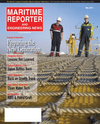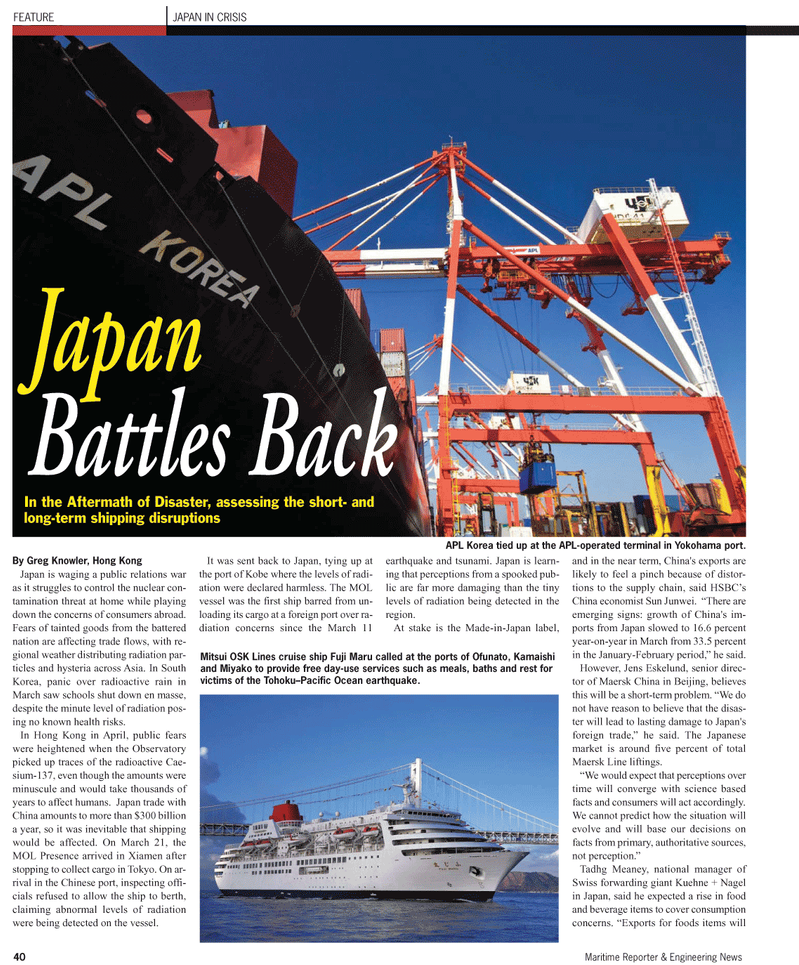
Page 40: of Maritime Reporter Magazine (May 2011)
Training & Education Edition
Read this page in Pdf, Flash or Html5 edition of May 2011 Maritime Reporter Magazine
FEATURE JAPAN IN CRISIS
By Greg Knowler, Hong Kong
Japan is waging a public relations war as it struggles to control the nuclear con- tamination threat at home while playing down the concerns of consumers abroad.
Fears of tainted goods from the battered nation are affecting trade flows, with re- gional weather distributing radiation par- ticles and hysteria across Asia. In South
Korea, panic over radioactive rain in
March saw schools shut down en masse, despite the minute level of radiation pos- ing no known health risks.
In Hong Kong in April, public fears were heightened when the Observatory picked up traces of the radioactive Cae- sium-137, even though the amounts were minuscule and would take thousands of years to affect humans. Japan trade with
China amounts to more than $300 billion a year, so it was inevitable that shipping would be affected. On March 21, the
MOL Presence arrived in Xiamen after stopping to collect cargo in Tokyo. On ar- rival in the Chinese port, inspecting offi- cials refused to allow the ship to berth, claiming abnormal levels of radiation were being detected on the vessel.
It was sent back to Japan, tying up at the port of Kobe where the levels of radi- ation were declared harmless. The MOL vessel was the first ship barred from un- loading its cargo at a foreign port over ra- diation concerns since the March 11 earthquake and tsunami. Japan is learn- ing that perceptions from a spooked pub- lic are far more damaging than the tiny levels of radiation being detected in the region.
At stake is the Made-in-Japan label, and in the near term, China's exports are likely to feel a pinch because of distor- tions to the supply chain, said HSBC’s
China economist Sun Junwei. “There are emerging signs: growth of China's im- ports from Japan slowed to 16.6 percent year-on-year in March from 33.5 percent in the January-February period,” he said.
However, Jens Eskelund, senior direc- tor of Maersk China in Beijing, believes this will be a short-term problem. “We do not have reason to believe that the disas- ter will lead to lasting damage to Japan's foreign trade,” he said. The Japanese market is around five percent of total
Maersk Line liftings. “We would expect that perceptions over time will converge with science based facts and consumers will act accordingly.
We cannot predict how the situation will evolve and will base our decisions on facts from primary, authoritative sources, not perception.”
Tadhg Meaney, national manager of
Swiss forwarding giant Kuehne + Nagel in Japan, said he expected a rise in food and beverage items to cover consumption concerns. “Exports for foods items will
Japan
Battles Back
In the Aftermath of Disaster, assessing the short- and long-term shipping disruptions 40 Maritime Reporter & Engineering News
Mitsui OSK Lines cruise ship Fuji Maru called at the ports of Ofunato, Kamaishi and Miyako to provide free day-use services such as meals, baths and rest for victims of the Tohoku–Pacific Ocean earthquake.
APL Korea tied up at the APL-operated terminal in Yokohama port.

 39
39

 41
41
